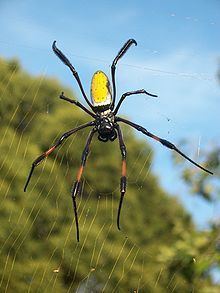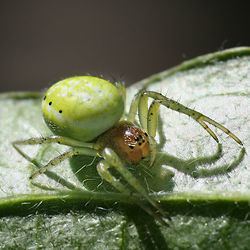Scientific name Araneomorphae Rank Infraorder | ||
 | ||
Lifespan Southern black widow: 1 – 3 years Diameter Southern black widow: 0.64 cm Length Southern black widow: 3.8 cm, Deinopis subrufa: 2.5 cm Lower classifications Similar Orb weaver spider, Entelegynae, Pholcidae | ||
A big spider araneomorphae sometimes referred to as labidognatha
Araneomorphae (sometimes referred to as Labidognatha) is an infraorder of spiders. They are distinguished by having fangs that oppose each other and cross in a pinching action, in contrast to the Mygalomorphae (Tarantulas and their close kin), which have fangs that are nearly parallel in alignment. With the exception of the Hypochilidae spiders, they have never more than a single pair of book lungs. Both Araneomorphae and Mygalomorphae belong to the suborder Opisthothelae, which comprises nearly all extant species of spider. Mesothelae, the only other suborder in Aranea, includes only about 100 living species.
Contents
- A big spider araneomorphae sometimes referred to as labidognatha
- Gro e schwarze spinne winkelspinne araneomorphae hausspinne m nnchen tegenaria black spider male
- Distinguishing characteristics
- Mygalomorphae
- Araneomorphae
- Spiders included
- Systematics
- References

Gro e schwarze spinne winkelspinne araneomorphae hausspinne m nnchen tegenaria black spider male
Distinguishing characteristics

Note the difference in the orientations of the fangs of the two spiders below, representatives of the Mygalomorphae and the Araneomorphae.
Mygalomorphae

Atrax robustus (a member of the Hexathelidae) is making a threat display, and by so doing shows very clearly the orientation of its fangs, which go up and down, parallel to the long axis of the spider'S body. So it is a representative of the suborder Mygalomorphae, not Araneomorphae.
Araneomorphae
In Araneomorphae, the fangs slope towards each other, giving these spiders many more possibilities than Mygalomorphae, which can only bite top down.
Unlike Mygalomorphae, which can live for up to 25 years, most Araneomorphae die after about a year.
Spiders included
The vast majority of extant spider species are included in this group. The exceptions belong to the infraorder Mygalomorphae, which includes tarantulas, trapdoor spiders and several families of funnel-web spiders, and the suborder Mesothelae, which includes about 100 species living in Asia. The Araneomorphae include the orb-weaver spiders, the cobweb spiders, the crab spiders, the jumping spiders, the wolf spiders, and the large huntsman spiders.
Systematics
As of 2015, precise details of the internal division of the araneomorphs are unclear. There are two main clades: the Haplogynae and the Entelegynae. The position of the two small clades Hypochilidae and Austrochiloidea, remains uncertain: some analyses place them outside the Haplogynae, as shown below. Earlier analyses regarded the Hypochilidae as the sole representatives of a group called the Paleocribellatae, with all other araneomorphs placed in the Neocribellatae. More recent analyses place the Austrochiloidea between the Haplogynae and the Entelegynae, or group the Hypochilidae with the Haplogynae. Most spiders in the Haplogynae have six eyes, while most of those in the Entelegynae series have eight.
